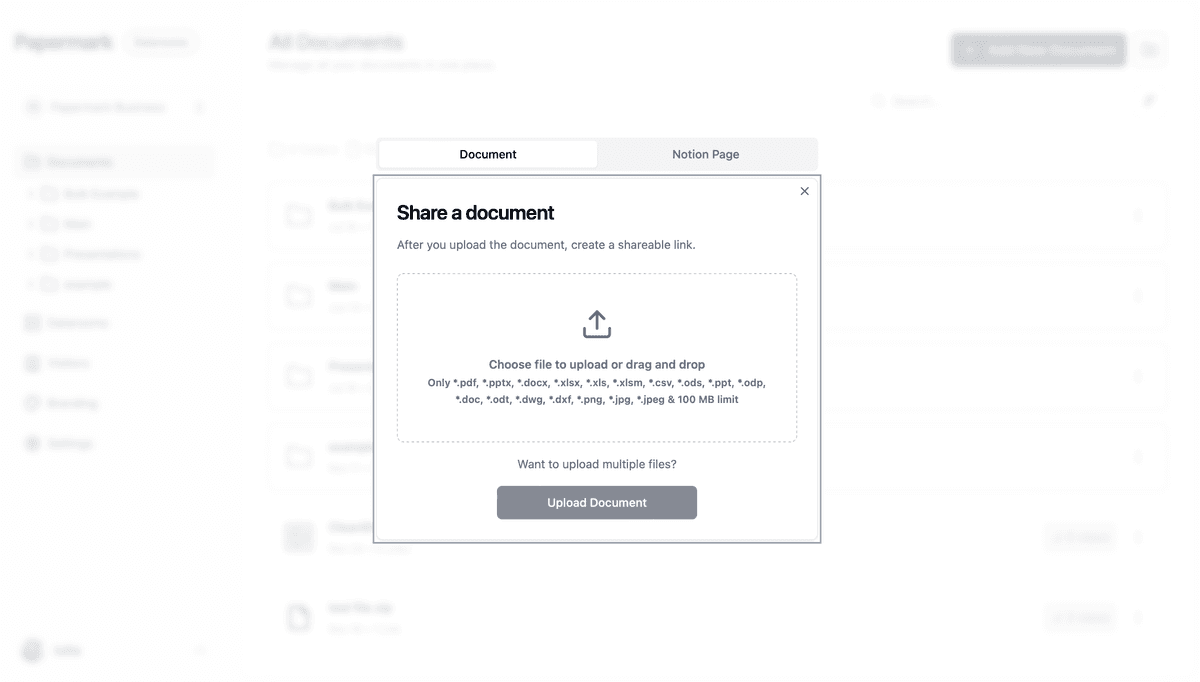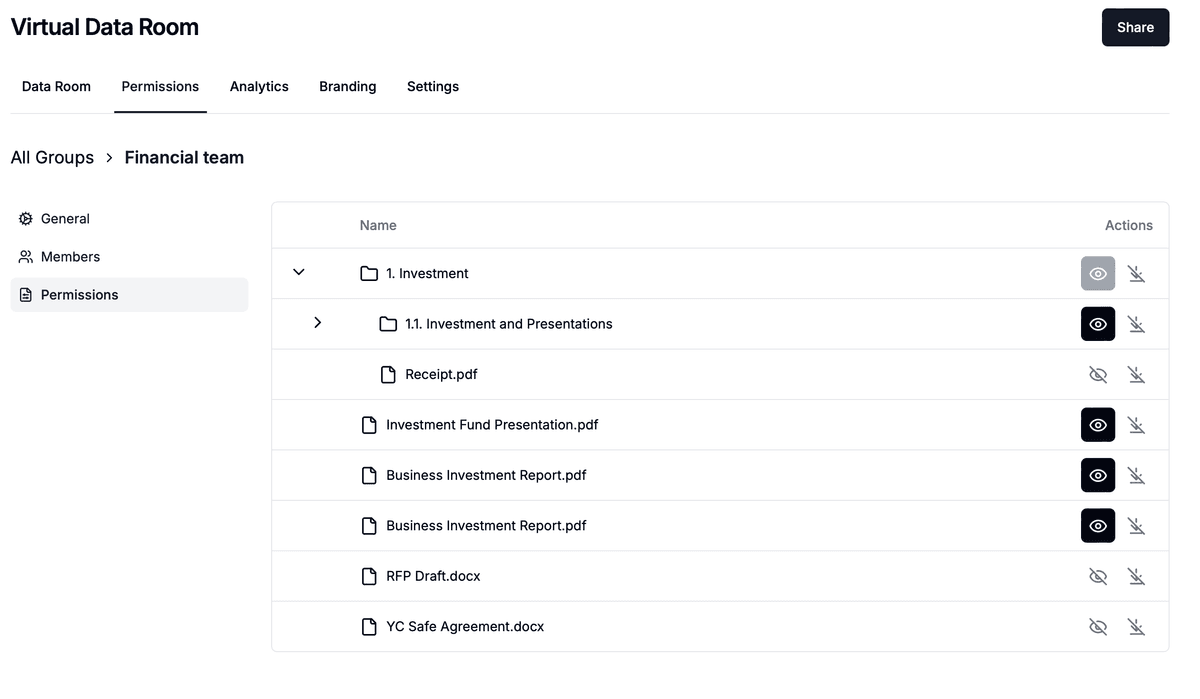How to Create a Sales Pitch Deck That Actually Closes Deals
Creating a sales pitch deck is one of the most critical aspects of the sales process. With attention spans shorter than ever and decision-makers reviewing countless presentations, your deck needs to stand out and deliver results. In fact, studies show that prospects spend an average of just 3 minutes reviewing a sales pitch deck before making a decision.
In this comprehensive guide, you'll discover proven deck structures, learn best practices for design and content, and understand how to leverage Papermark's tracking features to monitor engagement and optimize your approach.
What is a Sales Pitch Deck?
A sales pitch deck is a visual presentation designed to persuade potential customers to purchase your product or service. Unlike investor pitch decks (which focus on securing funding), sales pitch decks are specifically crafted to address customer pain points, showcase your solution's benefits, and drive purchasing decisions.
Key characteristics of an effective sales pitch deck include:
- Customer-centric focus: Addresses the prospect's specific challenges and needs
- Clear value proposition: Articulates exactly how your solution delivers value
- Visual storytelling: Uses imagery and design to engage and persuade
- Concise messaging: Distills complex information into digestible, compelling points
- Action-oriented: Guides prospects toward a specific next step
Sales pitch decks serve multiple purposes throughout the sales process:
- Initial outreach: Introduce your solution to new prospects
- Discovery meetings: Guide conversations about customer needs
- Solution presentations: Demonstrate how your product addresses specific challenges
- Proposal follow-ups: Reinforce value and address objections
- Closing conversations: Provide final details and encourage purchase
What to include in a sales pitch deck
A well-structured sales pitch deck follows these key elements:
| Element | Guidelines | Example |
|---|---|---|
| Opening slide | • Clear value proposition • Compelling headline • Visual that captures attention • Company logo and contact info | Transform [Industry] Operations with [Your Solution] |
| Problem statement | • Identify specific pain points • Use industry statistics • Include visual representation • Make it relatable | Companies lose $X billion annually due to [specific problem] |
| Solution overview | • Present your product/service • Highlight key differentiators • Use visuals over text • Keep it simple | Our platform solves [problem] by [unique approach] |
| How it works | • 3-5 key steps or features • Visual process flow • Focus on benefits • Include screenshots/demos | 1. [Step 1] 2. [Step 2] 3. [Step 3] |
| Social proof | • Customer testimonials • Case studies with metrics • Logos of recognizable clients • Industry recognition | Trusted by [Company Names] [Specific results achieved] |
| Pricing/ROI | • Clear value proposition • Pricing tiers if applicable • ROI calculation • Implementation timeline | Achieve [X%] ROI within [timeframe] |
| Call to action | • Clear next steps • Multiple contact options • Create urgency • Make response easy | Schedule a demo today [Contact information] |
Sales pitch deck templates
Template 1: Problem-Solution-Proof approach
This classic structure is effective for most B2B sales situations.
Slide 1: Title
- Company name and logo
- Compelling headline
- Your name and contact info
Slide 2: Problem Statement
- Industry pain points with statistics
- Visual representation of the problem
- Cost of inaction
Slide 3: Solution Overview
- Your product/service name
- Tagline that captures value
- Key differentiator
Slide 4: How It Works
- 3-5 step process
- Visual workflow
- Key features with benefits
Slide 5: Social Proof
- Customer testimonials
- Case study with metrics
- Client logos
Slide 6: Pricing/ROI
- Pricing tiers (if applicable)
- ROI calculation
- Implementation timeline
Slide 7: Call to Action
- Next steps
- Contact information
- Meeting scheduler link
Template 2: Story-based approach
This narrative structure is effective for complex solutions or consultative selling.
Slide 1: Title
- Company name and logo
- Story headline
- Your name and contact info
Slide 2: The Challenge
- Industry context
- Specific challenges faced
- Visual representation
Slide 3: The Journey
- Common approaches tried
- Why they fail
- Cost of traditional solutions
Slide 4: The Discovery
- How your solution was developed
- Unique approach
- Key differentiators
Slide 5: The Solution
- Your product/service
- How it works
- Key features with benefits
Slide 6: The Results
- Customer success stories
- Before/after metrics
- Industry recognition
Slide 7: The Path Forward
- Implementation process
- Timeline and milestones
- Support and resources
Slide 8: Call to Action
- Next steps
- Contact information
- Meeting scheduler link
Template 3: Value-focused approach
This structure emphasizes ROI and business impact, ideal for executive audiences.
Slide 1: Title
- Company name and logo
- Value proposition headline
- Your name and contact info
Slide 2: Executive Summary
- Brief overview of solution
- Key benefits
- Target audience
Slide 3: Market Opportunity
- Industry size and growth
- Market trends
- Competitive landscape
Slide 4: Business Impact
- Cost savings
- Revenue increase
- Efficiency gains
- Risk reduction
Slide 5: Solution Overview
- Product/service features
- How it works
- Integration capabilities
Slide 6: Implementation
- Timeline
- Process
- Support and training
Slide 7: ROI Analysis
- Cost breakdown
- Return calculation
- Payback period
Slide 8: Call to Action
- Next steps
- Contact information
- Meeting scheduler link
Where to make your sales pitch deck
Choosing the right tool to create your sales pitch deck is crucial for both design quality and sharing capabilities. Here are the most popular options:
| Tool Type | Tool Name | Key Features | Best For |
|---|---|---|---|
| Presentation Software | Microsoft PowerPoint | • Industry standard with extensive features • Professional templates and design tools • Seamless integration with Microsoft ecosystem • Export to PDF or online sharing via OneDrive | Teams already using Microsoft products who need advanced features |
| Presentation Software | Google Slides | • Free and cloud-based for easy collaboration • Simple interface with essential features • Automatic saving and version history • Direct sharing via links | Teams needing real-time collaboration on a budget |
| Presentation Software | Apple Keynote | • Elegant design templates • Smooth animations and transitions • High-quality visual capabilities • Export to various formats | Mac users who prioritize design aesthetics |
| Specialized Pitch Deck Tools | Canva | • User-friendly drag-and-drop interface • Extensive template library • Design-focused approach • Export to multiple formats | Non-designers who need professional-looking decks quickly |
| Specialized Pitch Deck Tools | Beautiful.ai | • AI-powered design suggestions • Smart templates that adapt to content • Brand consistency features • Analytics for presentation engagement | Teams needing AI assistance for design and analytics |
| Specialized Pitch Deck Tools | Pitch | • Purpose-built for pitch decks • Modern, clean design aesthetic • Interactive elements and animations • Built-in analytics | Startups and modern companies focused on design |
The best way to send and analyze your sales pitch
Creating a compelling sales pitch deck is only half the battle. The real challenge is understanding how prospects interact with your presentation after you send it. Without proper tracking and analytics, you're operating blindly—unable to know if your message is reaching decision-makers or generating interest.
This lack of visibility creates critical inefficiencies in your sales process:
- You waste time following up with uninterested prospects
- You miss opportunities with highly engaged prospects
- You can't identify which parts of your pitch resonate most with stakeholders
- You risk losing valuable intellectual property through unauthorized sharing
Modern sales enablement tools like Papermark transform this challenge by providing:
- Real-time visibility into prospect engagement
- Behavioral insights about which slides capture attention
- Extended reach tracking to see who else in the organization views your content
- Content protection through dynamic watermarking
With these insights, you can focus your follow-up efforts on genuinely interested prospects, dramatically improving your conversion rates and sales efficiency.
Setting up trackable pitch links
Getting started with Papermark is straightforward:
- Access your Papermark dashboard: Create a free account
- Configure tracking: Enable the analytics features that matter most to you
- Add security layers: Set up password protection or other security measures as needed

Understanding prospect engagement
Papermark's analytics dashboard gives you unprecedented visibility into how prospects interact with your pitch deck:
- See exactly when your prospect first opened your deck
- Track how much time they spend on each slide
- Identify which sections they revisit
- Get instant notifications when engagement occurs

Additional features
Papermark offers several advanced capabilities specifically designed for sales teams:
- Intelligent watermarking:
- Automatically embeds the viewer's identity and access time
- Allows customization of watermark placement and style
- Creates accountability and discourages unauthorized sharing
- Provides an audit trail of document access

- Content protection:
- Blocks unauthorized screenshots across all devices
- Automatically blurs content when screenshot attempts are detected
- Works seamlessly across desktop and mobile platforms
- Maintains detailed logs of any security breach attempts

Building comprehensive sales data rooms
For complex sales cycles requiring multiple documents, Papermark's data rooms provide an elegant solution:
- Structure your data room:
- Organize documents into logical categories
- Create sections for different aspects of your pitch (e.g., case studies, pricing, implementation)
- Establish granular permission controls
- Apply consistent security policies across all content

-
Streamline document management:
- Upload entire collections of files at once
- Maintain your organizational structure
- Set document-specific access controls
- Apply security features consistently
-
Share with confidence:
- Generate a single, secure access point for your entire data room
- Control who can access what content
- Track engagement across all documents in one view
- Receive alerts when prospects access any content

Ready to create winning sales pitch decks?
Creating a sales pitch deck doesn't have to be a shot in the dark. By following these best practices and leveraging Papermark's tracking features, you can ensure your decks are both professional and effective, while gaining valuable insights into prospect engagement.
